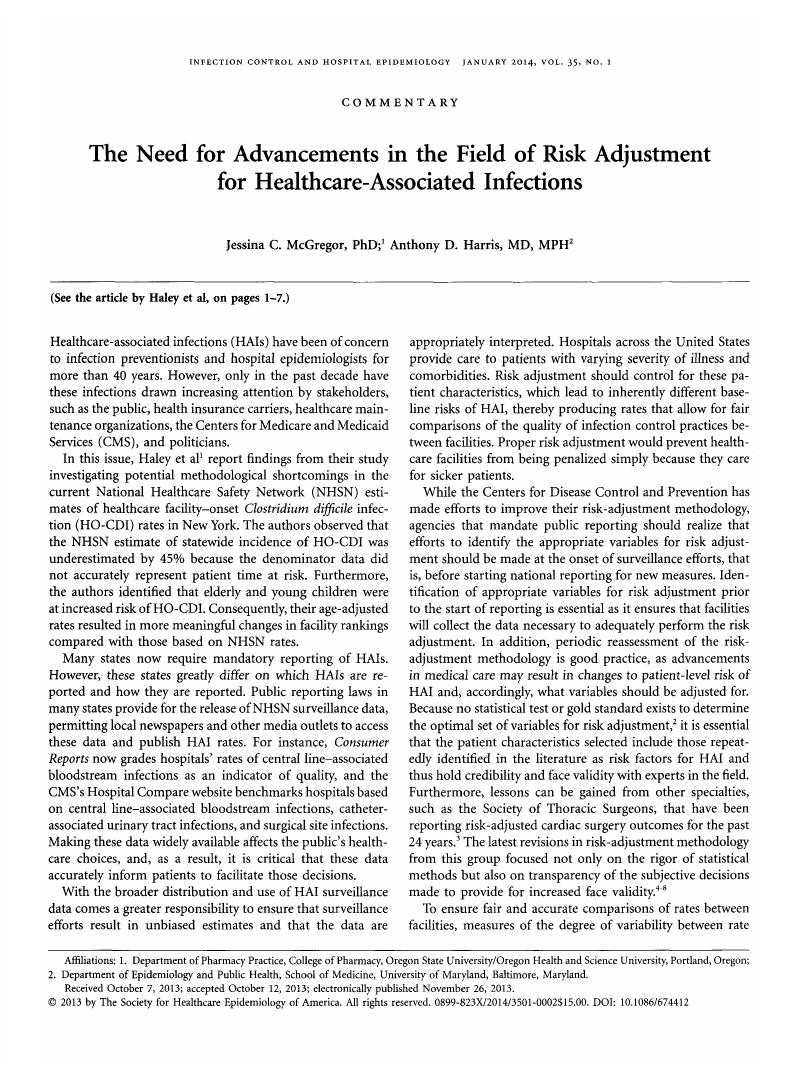Crossref Citations
This article has been cited by the following publications. This list is generated based on data provided by Crossref.
Fukuda, H.
2016.
Patient-related risk factors for surgical site infection following eight types of gastrointestinal surgery.
Journal of Hospital Infection,
Vol. 93,
Issue. 4,
p.
347.
Thompson, Nicola D.
Edwards, Jonathan R.
Dudeck, Margaret A.
Fridkin, Scott K.
and
Magill, Shelley S.
2016.
Evaluating the Use of the Case Mix Index for Risk Adjustment of Healthcare-Associated Infection Data: An Illustration using Clostridium difficile Infection Data from the National Healthcare Safety Network.
Infection Control & Hospital Epidemiology,
Vol. 37,
Issue. 1,
p.
19.
Hollenbeck, Brian L.
McGuire, Kevin J.
White, Andrew P.
Yassa, David S.
and
Wright, Sharon B.
2017.
Invasiveness Index as a Predictor of Surgical Site Infection after Spinal Fusion, Revision Fusion, or Laminectomy.
Infection Control & Hospital Epidemiology,
Vol. 38,
Issue. 1,
p.
11.
Harris, Anthony D.
Sbarra, Alyssa N.
Leekha, Surbhi
Jackson, Sarah S.
Johnson, J. Kristie
Pineles, Lisa
and
Thom, Kerri A.
2018.
Electronically Available Comorbid Conditions for Risk Prediction of Healthcare-Associated Clostridium difficile Infection.
Infection Control & Hospital Epidemiology,
Vol. 39,
Issue. 3,
p.
297.
Spaulding, Aaron
Paul, Rachel
and
Colibaseanu, Dorin
2018.
Comparing the Hospital-Acquired Condition Reduction Program and the Accreditation of Cancer Program: A Cross-sectional Study.
INQUIRY: The Journal of Health Care Organization, Provision, and Financing,
Vol. 55,
Issue. ,
Valentine, Jake C
Hall, Lisa
Verspoor, Karin M
and
Worth, Leon J
2019.
The current scope of healthcare-associated infection surveillance activities in hospitalized immunocompromised patients: a systematic review.
International Journal of Epidemiology,
Vol. 48,
Issue. 6,
p.
1768.
Dube, William C.
Jacob, Jesse T.
Zheng, Ziduo
Huang, Yijian
Robichaux, Chad
Steinberg, James P.
and
Fridkin, Scott K.
2020.
Comparison of Rates of Central Line–Associated Bloodstream Infections in Patients With 1 vs 2 Central Venous Catheters.
JAMA Network Open,
Vol. 3,
Issue. 3,
p.
e200396.
Boamah, Sheila A.
Hamadi, Hanadi Y.
and
Spaulding, Aaron C.
2022.
Hospital-Acquired Conditions Reduction Program, Racial and Ethnic Diversity, and Magnet Designation in the United States.
Journal of Patient Safety,
Vol. 18,
Issue. 7,
p.
e1090.



